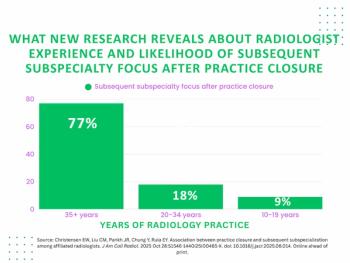
What Administrators Need to Know about Imaging Informatics
A high-level overview of imaging informatics for the radiology administrator, from AHRA 2017.
In today's expanding medical technology environment, imaging informatics has taken on a large and important role in radiology. It touches your workflow, your patient care, and your reimbursement, but it can also be confusing.
And, if you're an administrator, the responsibility for using imaging informatics in a progressive way that improves quality falls on your shoulders. The problem, however, is that this area is likely outside your wheelhouse, said Kenneth Fazzino, Regional Practice Director with Envision Healthcare.
"Quality is owned by leadership. If leadership doesn't drive it, quality won't take hold," he said Tuesday during the 2017 AHRA annual meeting.
The good news, he said, is that you don't have to be an informatics expert. You only need to know enough to understand broadly how imaging informatics works and who you can rely on to get the jobs done correctly.
To get administrators up to speed, Fazzino offered a primer on how they can use informatics, the data it provides, and the benefits of bringing information technology (IT) staff into the fold.
Know Some Lingo: PACS, RIS, and electronic health records (EHR) are common enough terms that administrators are likely familiar with them and what these tools do for radiology. But, they should also be well-informed about other terms. For example, administrators should know that DICOM refers to pictures, and HL7 refers to words. They should also be comfortable talking about clinical decision support (CDS) because the deadline for mandated use looms on Jan. 1, 2018.[[{"type":"media","view_mode":"media_crop","fid":"61711","attributes":{"alt":"Kenneth Fazzino","class":"media-image media-image-right","id":"media_crop_5401835096128","media_crop_h":"0","media_crop_image_style":"-1","media_crop_instance":"7807","media_crop_rotate":"0","media_crop_scale_h":"0","media_crop_scale_w":"0","media_crop_w":"0","media_crop_x":"0","media_crop_y":"0","style":"float: right;","title":"Kenneth Fazzino","typeof":"foaf:Image"}}]]
Know Your Storage Needs: Diagnostic imaging requires a significant amount of bandwidth to process and manage the thousands of images it creates every day. The size of images is a growing concern, Fazzino said, because imaging is now being asked to share its storage space with other sub-specialties, including pathology, cardiology, oncology, and several others. Administrators must work with IT staff to ensure the facility has the bandwidth necessary to properly support the imaging volume at the fidelity level needed for proper diagnoses.
Involve IT in Projects: When launching a new project, don't wait to get IT involved until the end. Bring them onboard early on when you're identifying your goals and benchmarks. If you get their input sooner, they can step in and identify areas where they can save you time and effort. IT can also help you side-step failure. Never go live on a project without coordinating a staging and testing effort first. Doing this gives IT the opportunity to identify any problems spots and fix them before the project goes live with providers.
Dedicated IT Personnel: You can help your department tremendously by negotiating a dedicated IT staff member who can quickly address any needs you might have. Having fast technical support is critical for radiology, he said, because when your equipment goes down, much of a facility's activities screech to a halt. If you can't get the problem fixed, you'll likely be blamed. Be prepared to budget for having dedicated IT staff, however.
As an administrator, Fazzino said, it's also important to know some imaging informatics benefits you can offer your providers to improve their daily workflow.
Image Routing: If your PACS has the capability, your IT department can configure it to route images to providers by their subspecialty area. For instance, all head CTs would go directly to your neuroradiologist; all knee and shoulder scans would be funneled to a musculoskeletal specialist; and all scans of children would go to your pediatric radiologist. It's a measure that streamlines workflow, he said.
One Stop Log-In: It's a common complaint among providers, he said, that they only want to log into a system one time. Using lightweight director access pools (LDAP), it's possible for your providers to log into every system -- PACS, RIS, and EHR -- with a single log-in to your PACS.
Ultimately, Fazzino said, administrators should keep several points in mind when dealing with informatics.
1. Expect and appreciate change. Resisting change only drags out the experience and makes it harder on everyone. You don't have to like it, he said, but pretend that you're excited because your team is watching you.
2. Don’t expect to be the IT expert. That's not your job. Instead, concentrate on having the right IT people at the table for all project discussions.
3. Build strong relationships with people in your institution who can support you throughout your project efforts.
4. Understand the stress technology changes bring to staff and providers. This group is historically techno-phobic. Help them along by sharing the organization's vision and strategy for projects. Tell them what it is, what it will accomplish, and where the outcomes will take you.
You might not understand all the intricacies of imaging informatics and the details of what your IT staff does, but you should still be confident in the positive impact it brings to the table, Fazzino said.
"Your imaging informatics and IT could be a competitive advantage," he said. "If you're bringing something to the table that's different, it could set you apart."
Newsletter
Stay at the forefront of radiology with the Diagnostic Imaging newsletter, delivering the latest news, clinical insights, and imaging advancements for today’s radiologists.






























